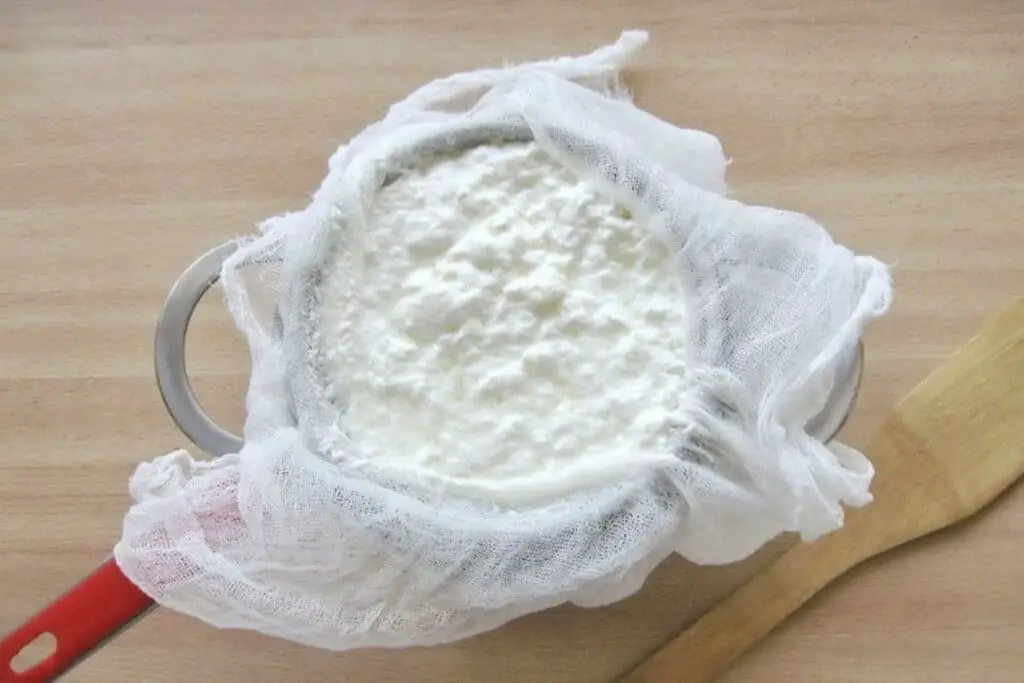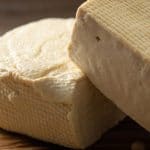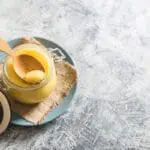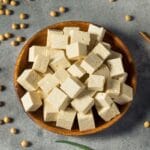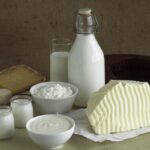Quick summary: You can use disposable coffee filters, muslin cloth, kitchen towel, or pantyhose as a quick alternative to cheesecloth. But some other fabrics in your home can also help you.
You might think cheesecloth is just used for making cheese, but it is in fact a very versatile piece of kitchen equipment. In addition to homemade cheese, it is also used to make ghee, tofu, strain nut milk, and for straining stocks.
The only drawback to using cheesecloth is that it can be pricey and difficult to find. If your recipe calls for cheesecloth and you can’t find any, there are a range of quick-fix alternatives you probably already have at home.
In this guide, we’ll help you choose the best cheesecloth substitute according to what you’re preparing.
What Is Cheesecloth?
Cheesecloth is a light porous material, very similar to medical gauze or cotton. The fabric functions well as a filter because of its fine weave.
This allows thin liquid to pass through while separating small particles. An ideal example is when making cheese. The cheesecloth keeps the milk proteins inside while allowing all the liquid whey to filter through.
The number of threads per square inch determines the cloth grade and density. Tightly woven cheesecloth is best for cheesemaking. If you can only find loosely woven fabric, you can always use it in a double layer.
What Is Cheesecloth Used For?
From cheese making and basting to soaking fruit cake and making bouquet garni, cheesecloth has many uses in the kitchen.
It can be used to keep chicken or turkey moist and succulent during roasting. Simply soak the cloth in your favorite marinade, olive oil, or melted butter and wrap it around the bird. Remove it 20 to 30 minutes before cooking is done to allow the exterior to crisp.
Placing cinnamon or powdered sugar in the cheesecloth and dusting it over pastries is the ideal way to create a thin, balanced dusting on baked goods.
Another popular use is to make a herb pouch, called a bouquet garni. It is very much like a tea bag for herbs and spices in cooking.
Wrapping your dried herbs into the cloth and tying it tightly allows you to infuse these flavors into a soup, sauce, or stew without having to pick or strain out all the whole leaves and twigs before serving.
Once your dish is ready, and the flavors are infused, simply remove the herb parcel.
Best Cheesecloth Substitutes
Disposable Coffee Filters
Since a coffee filter is designed to strain coffee grounds, it works well for straining other ingredients too. Coffee filters are woven in a similar manner but are a little finer and made of paper.
You do get reusable nylon filters, however, you might not want to use your coffee machine’s permanent reusable filter for other foods. It is very likely that residue will remain in the filter and your coffee will never taste the same again. This can also damage your coffee machine.
While paper filters make an ideal substitute for straining even the smallest particles, they are also less robust and are not suitable to use as a bouquet garni or for basting. A disposable coffee filter will tear when soaked for long periods.
Coffee filters come in different sizes and shapes. Large filters can be placed inside a regular large sieve over a bowl for liquids to drain.
Don’t add too much liquid at once since the filtration process is a little slower than using cheesecloth and will require more patience. Divide your mixture into two or three batches for separate straining for a more effective outcome.
The great thing about coffee filters is that they are easy to find and you can use biodegradable ones to keep your cooking environmentally friendly.
Muslin Cloth
Muslin fabric is probably the best option to replace cheesecloth since it has a similar weave.
The fabric has many benefits. It is 100% unbleached, made from organic cotton, environmentally friendly, and lightweight with a plain weave.
You can cut or simply tear it down to the size you need. It allows liquid and flavors to pass through easily while still holding back any small particles.
Muslin also dries quickly which prevents mold and bacterial growth. You can reuse it several times as long as you make sure to wash it well after every use.
Cotton Fabric Items
Cotton fabric is reputable for its breathability which makes it a top choice for summer clothing and bedding.
You can use almost any cotton item that you don’t need anymore including a t-shirt, sheet, or pillowcase.
Make sure the item is clean and that you have not used any detergent or softener when washing it as the floral scent and chemicals will seep through into your food. Also avoid using fabric that contains artificial dyes that can bleed into the food while straining.
This is a suitable substitute for almost any cooking application that calls for cheesecloth including straining yogurt and cheese curd.
Kitchen Towel
Although certain kitchen towels have a very fine weave compared to others, you can use them for effective straining, basting, or for making a bouquet garni.
One thing to remember with dish towels is that they are mainly designed to absorb liquid, so you may need to squeeze them out during the straining process.
Very importantly, make sure the dish towel has been washed without fragrant detergents or softeners before using it. Not only do you want to avoid bacteria from getting in your food from a dirty dish towel but you also don’t want the floral fragrance or chemicals from laundry detergent affecting the taste.
Buying a clean dish towel for straining liquids only is a good idea, just ensure that it does not contain dye that will leak into your food.
Pantyhose
Pantyhose, also sometimes referred to as stockings or sheer tights, are another superb option. As with the above, make sure they are washed well before using them to prevent bacteria and germs from infiltrating your food.
If you’re a little grossed out by using stockings in your cooking, buy a pair you can keep specifically for kitchen use. Even when using a brand-new, clean pair of tights, give them a wash in a diluted vinegar solution before using, and rinse them very well.
The foot area of the pantyhose makes a great pouch which is ideal for straining or making a spice pouch.
Make sure to wash them every single time after using them in the kitchen. Once they have been designated for kitchen use, don’t wear them again!
Socks
The mere thought of using socks in the kitchen is a little strange, but there’s finally a place for that single sock that no longer has a partner.
Thinner socks are a great substitute but we don’t recommend using woolies or thermals. As with the other fabric substitutes, make sure your sock is well-washed and completely clean before use.
The toe pouch makes this quite a handy shape for straining and its stretchability allows you to work with large and small quantities.
Medical Gauze
Gauze generally has a much looser weave than cheesecloth. All this means is that you will have to stack it in multiple layers to ensure you get a dense enough fabric to prevent tiny particles from draining out with the liquid.
Only ever use brand-new, clean gauze. This is usually included in a medicine box, first aid kit or easily available from a pharmacy or drugstore.
The downside to using gauze is that it can only be used once and is not always available in large sizes. It most likely will not fit over a large mixing bowl.
Fine Wire Sieve
Small wire or nylon sieves are generally thinner than regular sieves used for baking, but they aren’t quite as fine as cheesecloth.
This means they won’t be suitable for cheesemaking, straining ghee, tofu, or making almond milk. These are, however, a great option when you need to dust a little cocoa powder, powdered sugar, or cinnamon over pastries or pancakes. You can also use it to strain freshly squeezed juices.
The list is far from over. If you have a fine mesh bag, a flour sack towel, nut milk bag, a clean paint strainer bag, cloth napkin, straining cloths, or cotton handkerchiefs, you can use any of these as cheesecloth alternatives.
FAQ
Is the cheese cloth machine washable?
Yes, cheese cloth is machine washable. After use, you can either hand wash or machine wash the fabric. We recommend cleaning cheesecloth by rinsing out all the food first and not using detergents or fabric softeners. Ideally, give it a wash in diluted white vinegar and baking soda and rinse well.
Do I need to wash cheesecloth before using it for the first time?
Yes, you need to wash cheesecloth before using it for the first time. Iit is highly recommended that new cheesecloth be rinsed before using it for the first time. Since it will come in direct contact with food, you want to eliminate the chance of any dust, bacteria, and mold getting into your dish.
Can cheesecloth be reused?
Yes, cheesecloth can be reused but this may depend on what you are using it for. In most cases, it can be reused as long as it is washed straight after every use and allowed to dry completely to prevent mold and bacterial growth. If the cloth develops a smell or remaining food particles can’t be removed (such as sticky rice), discard it and switch to a new cloth.
Can I use a paper towel as a cheesecloth substitute?
Yes, you can use a paper towel instead of cheesecloth but only in some cases. However, it shouldn’t be one of your first options. Since it is thin, you will have to use multiple layers and you will have to switch it out a number of times during the straining process. The paper towel will become soggy very quickly and can tear or end up in your dish.
Conclusion
Cheesecloth is not the type of kitchen accessory you’ll find at a general grocery store. If you’re trying to make your own cheese, steamed sticky rice, nut milk, tofu, or ghee, there are a few other options you can use in flash.
The main thing to remember when choosing your substitute for cheesecloth is the density of the weave.
While thin weaves will allow liquids through easily, they may not be sufficient for straining out solid particles. Thick fabrics, on the other hand, will take very long to allow liquids to drain and may absorb a lot of the moisture.
Whichever option you choose, make sure your fabric is clean before every use.
Happy experimenting!
*image by PavSub/depositphotos
